
 Image: Adam Patrick Murray / IDG
Image: Adam Patrick Murray / IDG
The GeForce RTX 4090 is an absolute monster of a graphics card, but the battle for the next generation of GPUs is only getting started. On Thursday, AMD revealed its own 4K gaming champion, and the Radeon RX 7900 XTX and 7900 XT aim to topple Nvidia’s goliath with help from a stash of smart tricks that could make David himself blush.
In addition to improved ray tracing capabilities, the addition of AI cores, and memory galore, these first RDNA 3-architecture GPUs are also the first graphics cards featuring a multi-die “chiplet” design, swiping inspiration from AMD’s epic Ryzen success.
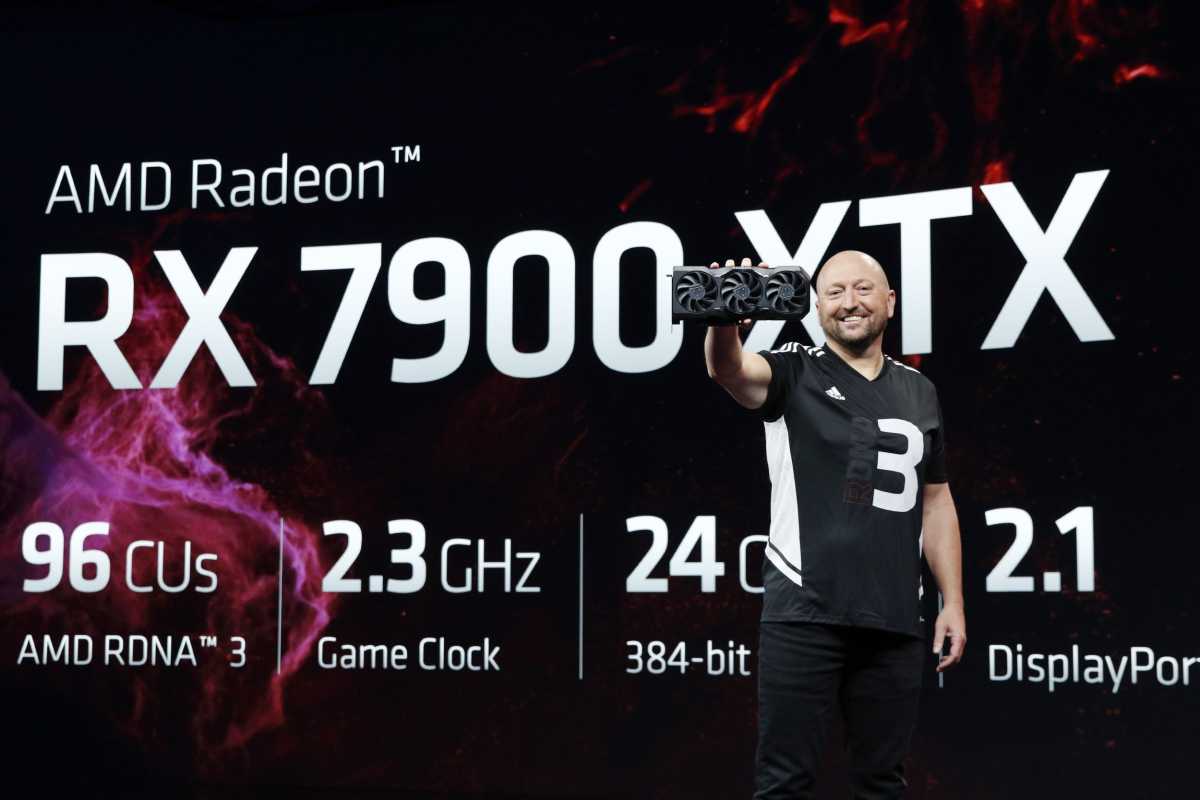
AMD Navi Launch in Las Vegas, Nevada, Thursday, November 3, 2022.
(Photo by PaulSakuma.com Photography)
AMD Navi Launch in Las Vegas, Nevada, Thursday, November 3, 2022.
(Photo by PaulSakuma.com Photography)
Adam Patrick Murray / IDG
AMD Navi Launch in Las Vegas, Nevada, Thursday, November 3, 2022.
(Photo by PaulSakuma.com Photography)
Adam Patrick Murray / IDG
Adam Patrick Murray / IDG
Better yet? Just like when Ryzen disrupted Intel’s stranglehold on CPUs, moving to chiplets helps AMD drastically undercut Nvidia’s pricing. While the RTX 4090 costs a chest-clutching $1,599, and the impending GeForce RTX 4080 costs $1,199, the new 24GB Radeon RX 7900 XTX costs $999 and the 20GB RX 7900 will cost $899 when they launch on December 13.
Even if AMD’s flagship doesn’t manage to go quite toe-to-toe with Nvidia’s beast when the benchmark dust finally settles, it should still be insanely fast—and sport a much more palatable price tag.
Let’s dig in.
Meet AMD’s RDNA 3 chiplets
Comparing AMD and Nvidia’s strategies to David and Goliath seems especially salient here. Nvidia slammed the pedal to the metal with its new “Ada Lovelace” architecture in the RTX 4090. The 4090 packs a gigantic 608mm2 GPU, crammed with 76.3 billion transistors. Those envelop everything you’d normally expect in a GPU die, from media and display engines to the memory controls. It truly is a goliath of a GPU.

AMD
AMD
AMD
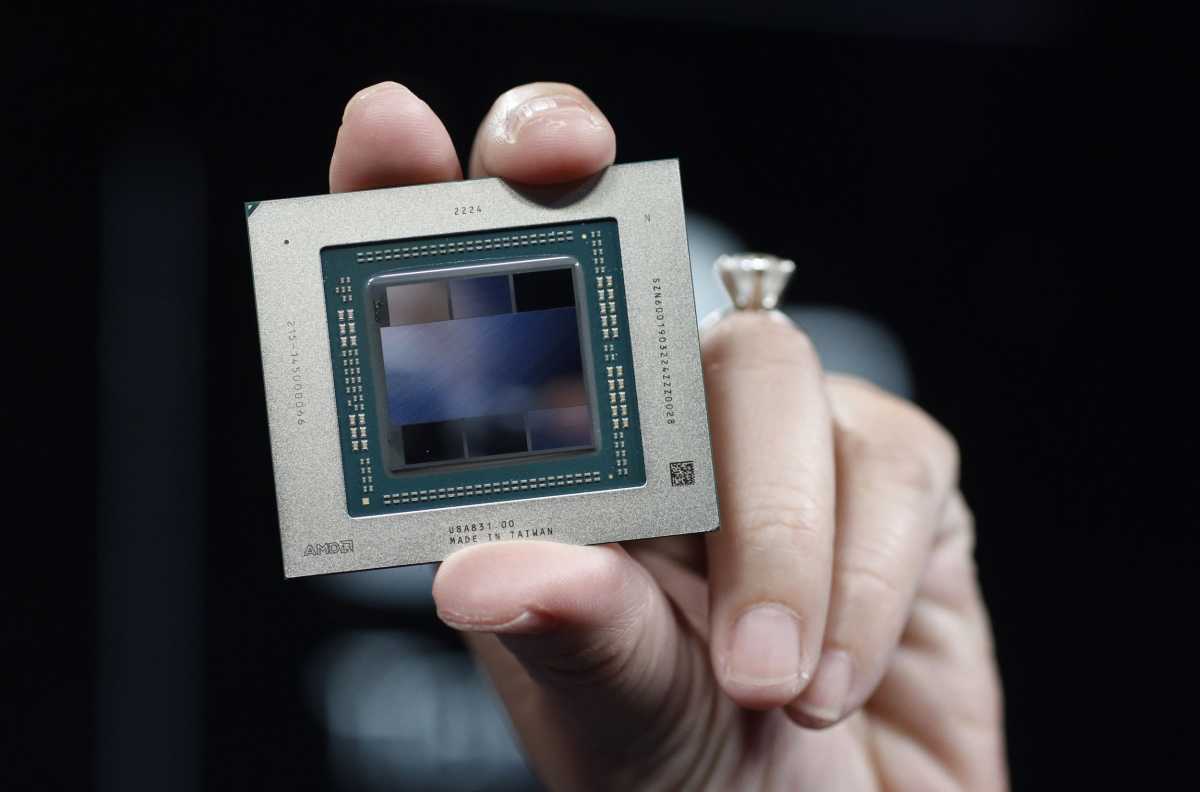
AMD Navi Launch in Las Vegas, Nevada, Thursday, November 3, 2022.
(Photo by PaulSakuma.com Photography)
AMD Navi Launch in Las Vegas, Nevada, Thursday, November 3, 2022.
(Photo by PaulSakuma.com Photography)
Adam Patrick Murray / IDG
AMD Navi Launch in Las Vegas, Nevada, Thursday, November 3, 2022.
(Photo by PaulSakuma.com Photography)
Adam Patrick Murray / IDG
Adam Patrick Murray / IDG
With RDNA 3 and the Radeon RX 7900 XTX, AMD chose a different path. It still contains a central GPU die, of course—you need one—but it measures a comparably paltry 300mm2, built using a 5nm TSMC manufacturing node similar to Nvidia’s. That’s because AMD split its GDDR6 memory interface and second-generation Infinity Cache into separate dies—six in total—made using the more mature and cost-efficient 6nm node. It’s a radical change for GPU design, and one that helps AMD keep costs down. All told, the Radeon RX 7900 XTX wields 58 billion transistors.
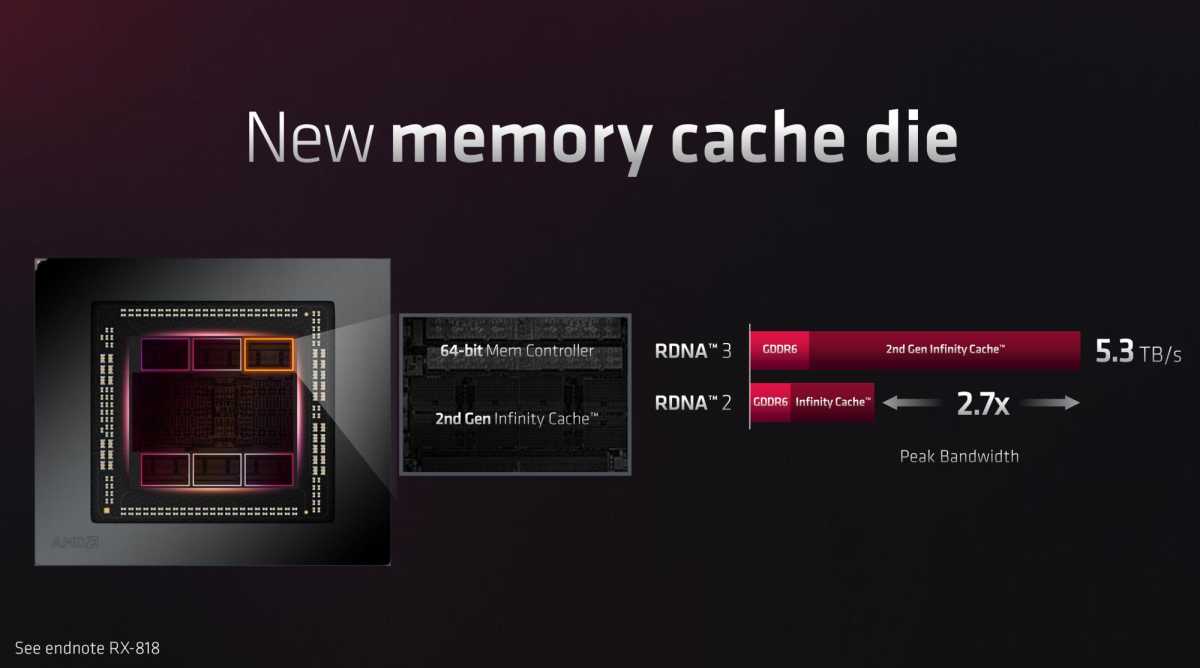
AMD
AMD
AMD
The Radeon RX 7900 XTX and 7900 XT each come equipped with 96MB of that Infinity Cache (which is basically on-die L3 cache for faster memory transfers and gaming speeds), with each of the six dies also sporting 64-bit memory controllers. That’s less than what the RDNA 2-based Radeon RX 6900 XT and 6800-series packed—those had 128MB—but AMD product technology architect Sam Naffziger explained that this version of Infinity Cache has been configured to do more with less, especially paired to the 24GB of GDDR6 memory over a broad 384-bit bus (or 20GB/320-bit bus in the 7900 XT’s case).
“We’ve tuned this Infinity Cache to enable better data reuse with less capacity to accomplish several things for us,” Naffziger said. “With the high hit rates, it directly sources most of the memory requests. This delivers data to the engine in less time and uses less power than going out to DRAM.” In sum, he said, RDNA 3’s Infinity Cache offers 2.7x the peak bandwidth provided by its successor, delivering up to 5.3 terabytes per second for instructions that stay within the GPU and Infinity Cache.
Bottom line: The Radeon RX 7900 XTX and 7900 XT won’t leave you wanting for memory.
Radeon RX 7900 XTX: Inside RDNA 3’s GPU upgrades
But don’t let the introduction of discrete memory dies fool you: The core RDNA 3 GPU also received some serious upgrades.
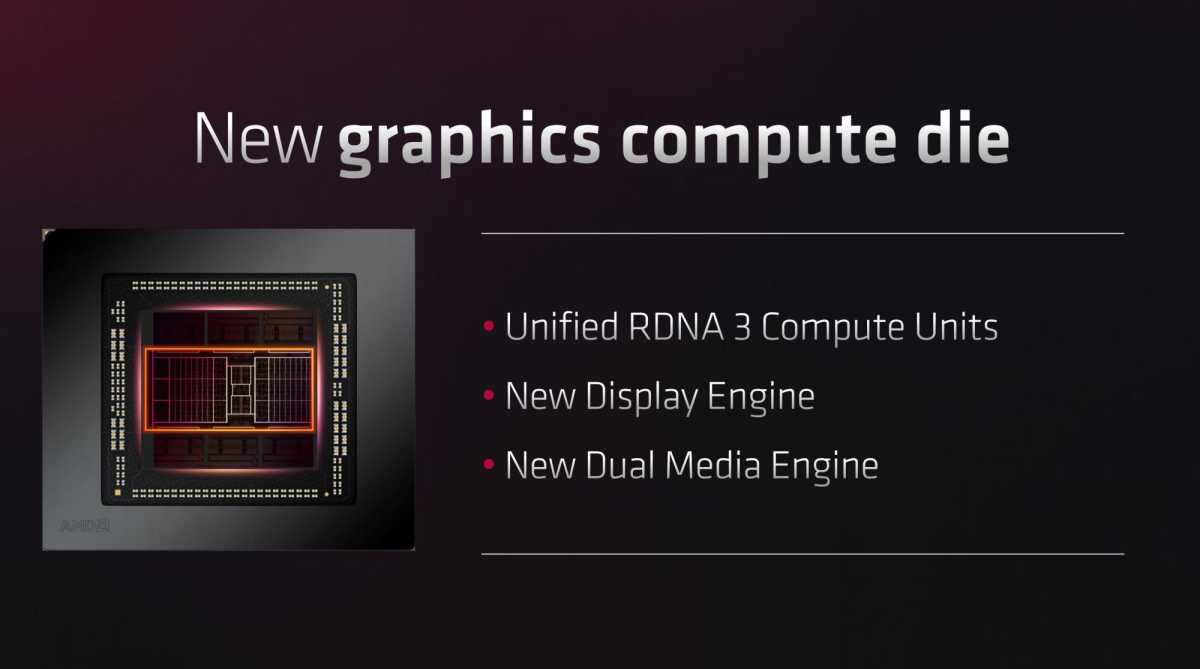
AMD
AMD
AMD
Architecture tweaks, the migration to TSMC’s advanced 5nm node, and splitting out the memory to its own trailing-node chiplet helped AMD exceed its efficiency goals, with CEO Lisa Su claiming that RDNA 3 offers 54 percent higher performance-per-watt than RDNA 2. That let AMD stick with a traditional 2x 8-pin power connector design, neatly side-stepping the melting 12VHPWR adapter controversy Nvidia finds itself embroiled in with the RTX 4090.
With RDNA 3, AMD managed to squeeze in 54 percent more transistors than with RDNA 2, in a smaller area, for an overall density improvement of 165 percent.

The modest power requirements help the Radeon RX 7900 XTX fit into traditional mid-tower PC cases much more easily than rival RTX 4090 GPUs.
The modest power requirements help the Radeon RX 7900 XTX fit into traditional mid-tower PC cases much more easily than rival RTX 4090 GPUs.
Adam Patrick Murray / IDG
The modest power requirements help the Radeon RX 7900 XTX fit into traditional mid-tower PC cases much more easily than rival RTX 4090 GPUs.
Adam Patrick Murray / IDG
Adam Patrick Murray / IDG
That’s all well and good, but gamers are more interested in what those fancy new RDNA 3 dies do. A deeper dive will no doubt come before the Radeon RX 7900 XTX’s December 13 launch date, but AMD provided some tantalizing morsels of information today.
RDNA 3 switches to a new “unified” compute unit that uses dual-issue wave 32 units, so AMD can issue either integer or floating point instructions as needed depending on the workload, which Naffziger says can speed up gaming frame rates and AI tasks alike. An enhanced general purpose register file with 50 percent more capacity than the RDNA 2 design likewise helps keep all tasks fed.
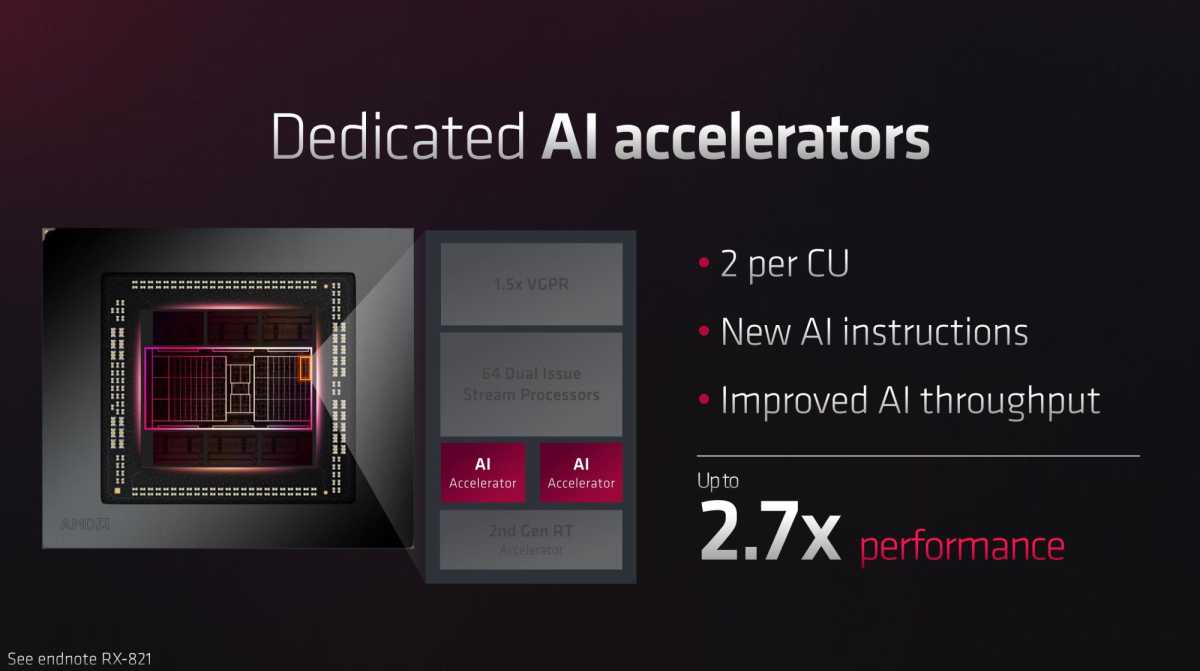
AMD
AMD
AMD
Yes, I said AI tasks. Two generations after Nvidia introduced tensor AI cores for DLSS and more in its RTX 20-series GeForce GPUs, AMD is finally following suit. Each RDNA 3 Compute Unit (CU) packs a pair of AI cores, as well as an enhanced ray tracing core that supports new dedicated instructions, 1.5x more rays in flight, and fresh ray box sorting and transversal capabilities.

AMD
AMD
AMD
AMD says RDNA 3 offers up to 50 percent more performance per CU than RDNA 2 did, which feels unlikely to catch up to Nvidia’s blistering RTX 40-series performance given the deficit AMD started in, but could make ray-traced games truly playable on RX 7000-series graphics cards. And you have to assume those AI cores will be put to work upsampling games before you know it—especially since Radeon chief Scott Herkelman teased FSR 3 for a 2023 release during this event, with a twofold increase in frame rates versus the already-impressive FSR 2.
Speaking of compute units, RDNA 3 might have a much smaller die, but it packs in many more CUs than before. The Radeon RX 6900 XT topped out at 80 CUs. The Radeon RX 7900 XTX has 96 running at 2.3GHz, while the 7900 XT offers 84 running at 2GHz.

AMD
AMD
AMD
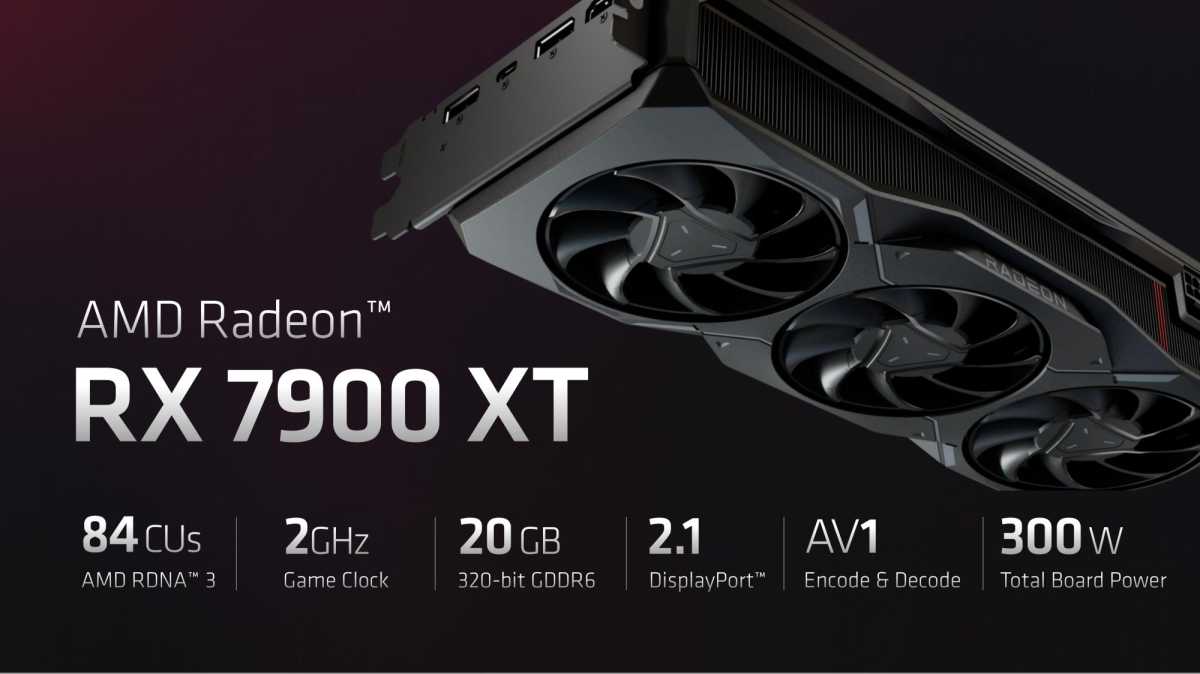
AMD
AMD
AMD
From traditional games to ray tracing to AI tasks, AMD’s new flagship should offer substantially more performance than before, as the AMD-supplied slides below illustrate. (That said, as always you should wait for independent benchmarks before judging a new graphics card—especially since these lack any RTX 4090 comparisons that could give us direct insight on how the Radeon RX 7900 XTX compares against Nvidia’s latest and greatest.)
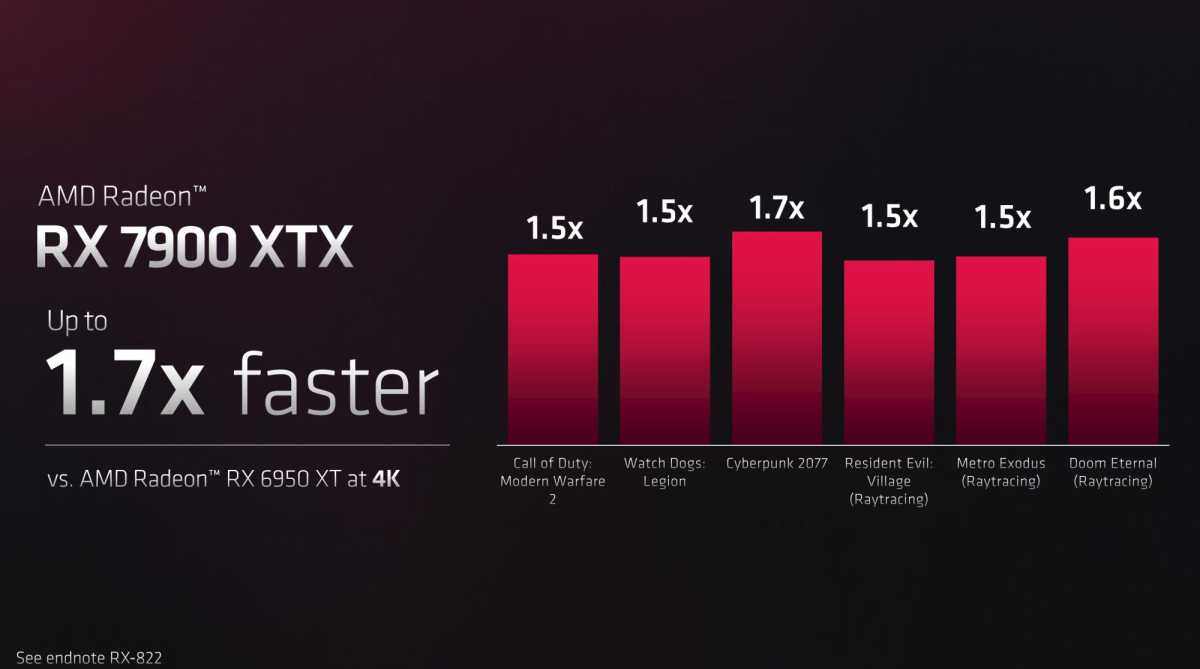
AMD
AMD
AMD
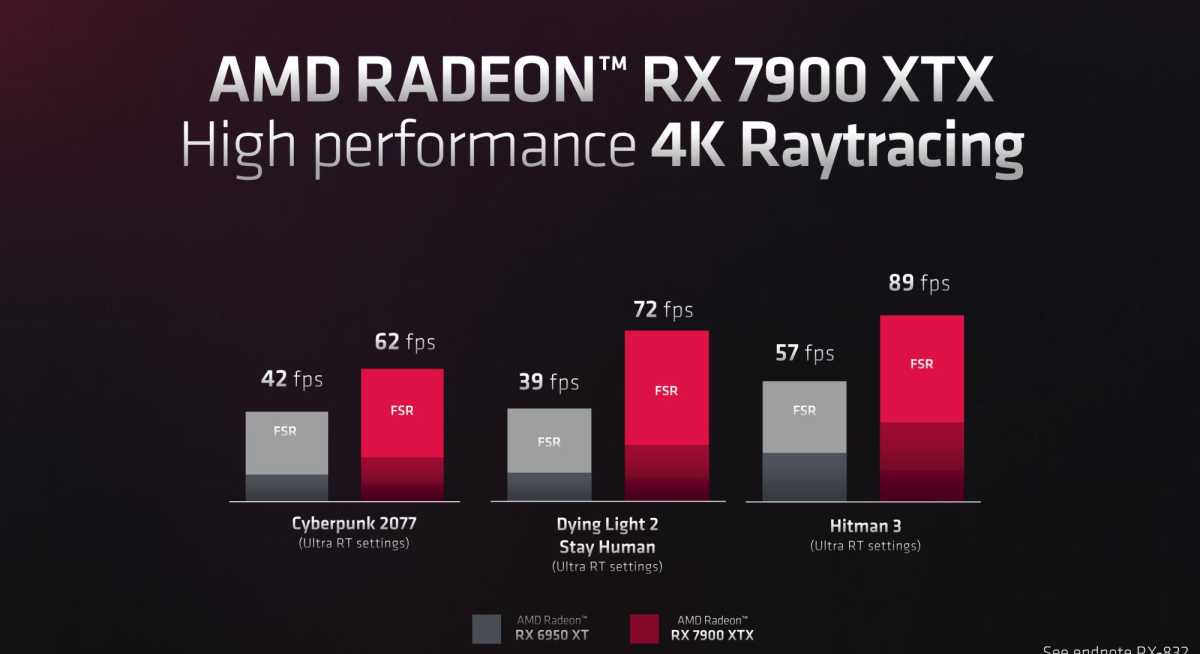
AMD
AMD
AMD

AMD
AMD
AMD
AMD also teased a new one-click “Hypr-RX” feature that can greatly enhance frame rates by activating FSR, Radeon Boost, and other helpful Radeon technologies. Like FSR 3, it’s coming in 2023—specifically the first half.
RDNA 3 media and display upgrades
Raw performance is only part of the package though. AMD also upgraded the media and display engines in RDNA 3.
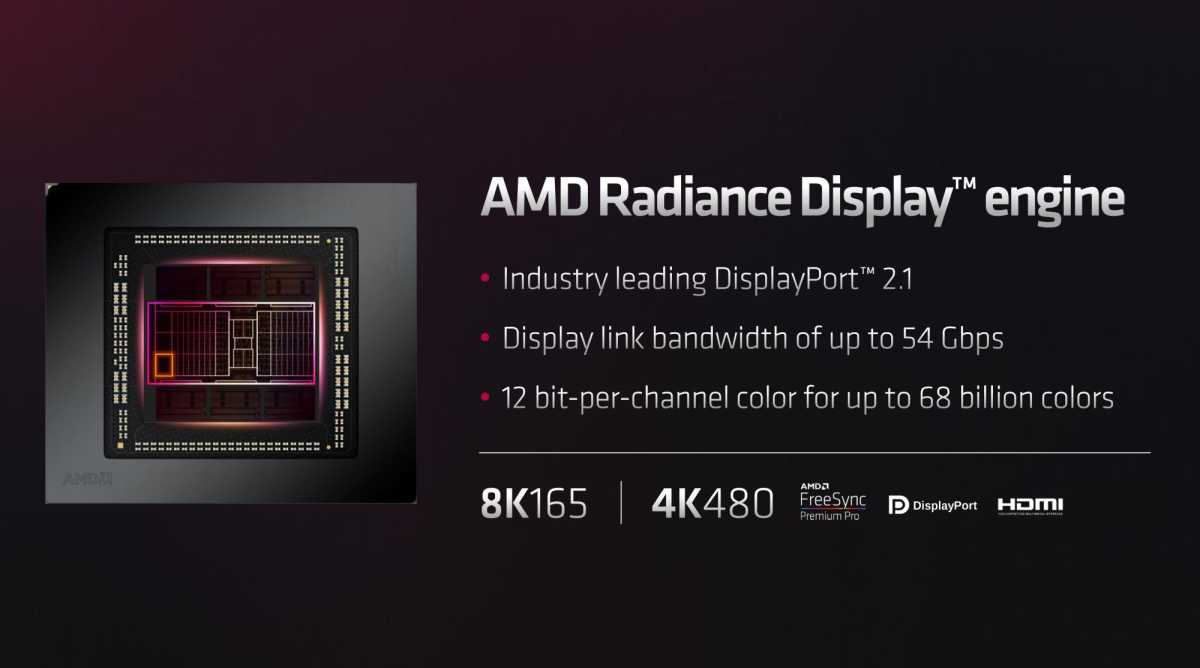
AMD
AMD
AMD
The Radeon RX 7900 XTX and 7900 XT support DisplayPort 2.1, unlike the GeForce RTX 4090. That means it can support 4K displays at up to a blistering 480Hz, or 8K displays at 165Hz. And 12 color bits per channel unlocks up to 68 billion colors, which is welcome, but seems more like stat porn than something anyone other than content creators need to worry about.
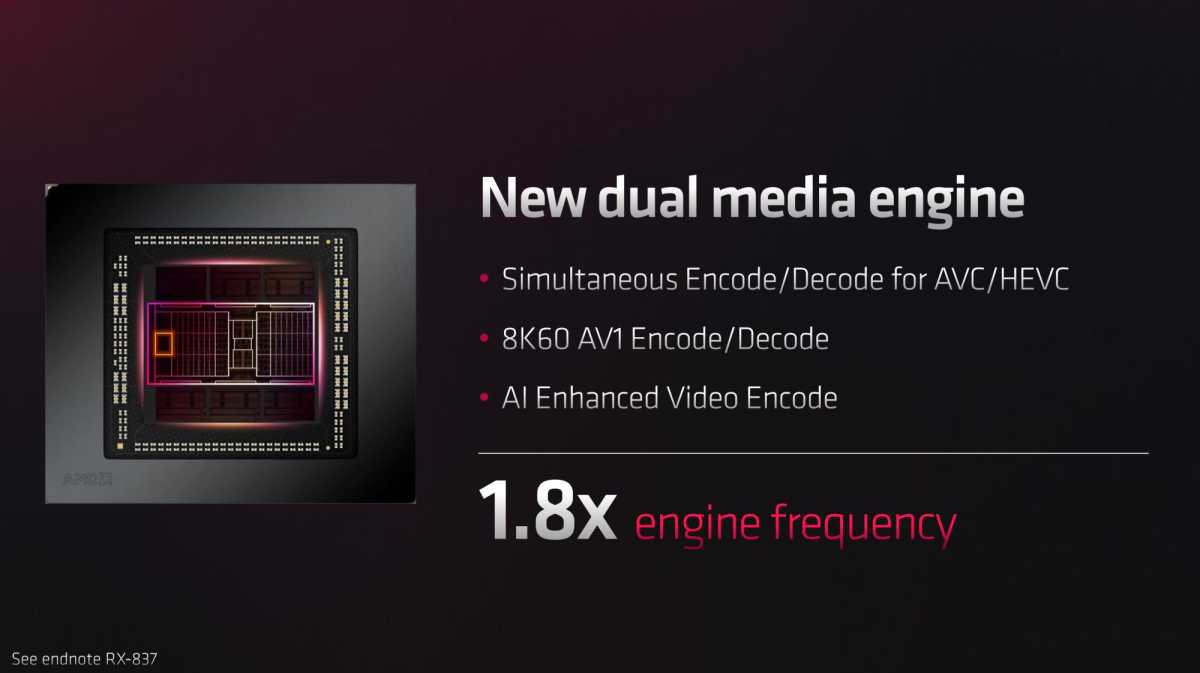
AMD
AMD
AMD
Nvidia and Intel hold the most sway with content creators, but AMD seriously upgraded its media engine with RDNA 3. Not only does it support AV1 encode and decode, joining Intel’s Arc and Nvidia’s RTX 40-series, but the GPU can also run simultaneous encode and decode for HEVC or AVC video. Accelerating the media engine’s frequency also helps it deliver up to 1.8x the performance of RDNA 2, Naffziger said, reducing export times. AMD’s new AI cores also come to bear here, with Naffziger promising improved video encoding and conference call quality thanks to their help.
A brewing battle
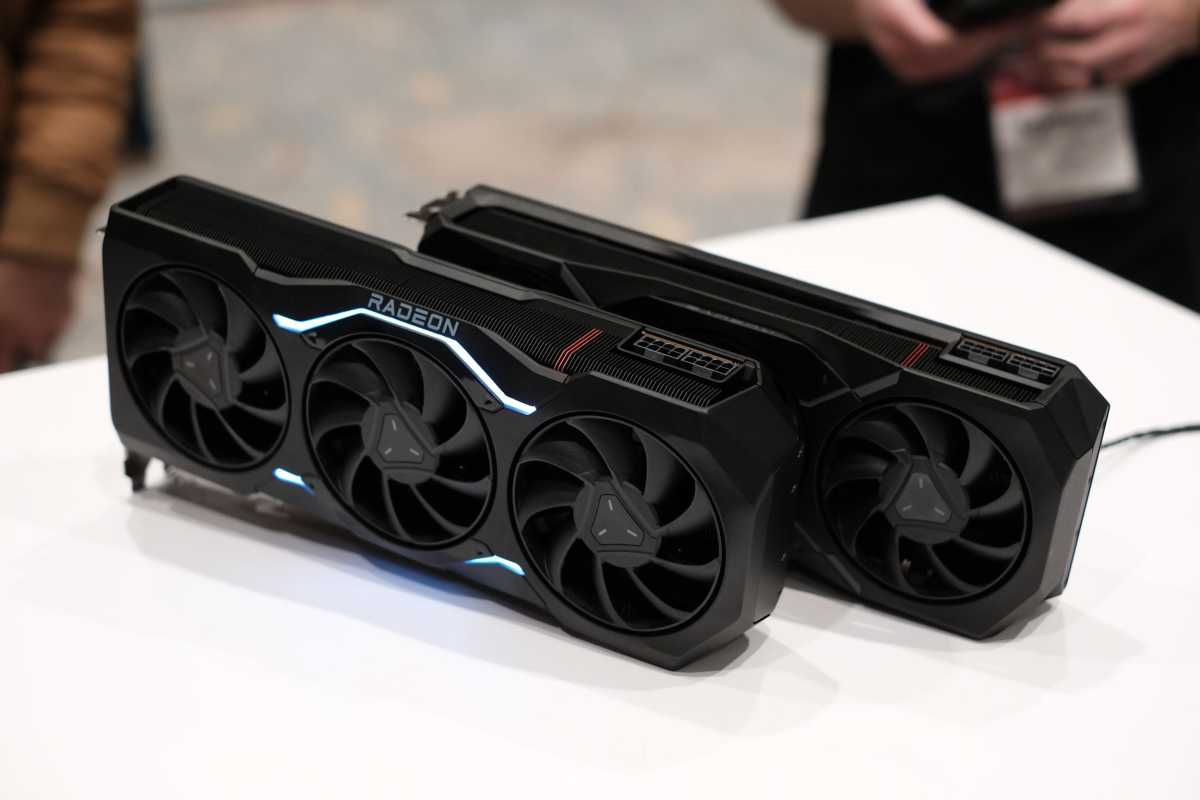
Adam Patrick Murray / IDG
Adam Patrick Murray / IDG
Adam Patrick Murray / IDG
After several disheartening years of shortages and sky-high prices, PC gamers finally have something to look forward to. The GeForce RTX 4090 rocked our socks, but its $1,600 price tag makes it a luxury toy for the 0.1 percent. The Radeon RX 7900 XTX and 7900 XT definitely aren’t cheap, at $999 and $899 respectively, but they’re a whole lot less than Nvidia’s initial offerings—and they appear primed to deliver an enthralling 4K+ gaming experience of their own on the back of several exciting innovations and beefed-up ray tracing capabilities.
AMD’s otherwise exciting presentation left us with plenty of questions, however. How will the Radeon RX 7900 XTX and 7900 XT stack up against the GeForce RTX 4090 and 4080, if not their own RDNA 2 predecessors? Does switching to multiple dies create any performance oddities? Will RDNA 3 finally deliver a compelling ray tracing experience? We’ll need to wait for independent benchmarks when these new-breed graphics cards hit the streets on December 13 to find out the answers.
Author: Brad Chacos, Executive editor

Brad Chacos spends his days digging through desktop PCs and tweeting too much. He specializes in graphics cards and gaming, but covers everything from security to Windows tips and all manner of PC hardware.
Recent stories by Brad Chacos:
Nvidia GeForce RTX 4080 Super review: The 4K graphics card you wantNew Arc drivers provide huge DX11 performance boost for Intel GPUsAudio Radar gives hearing impaired gamers a fair shot




